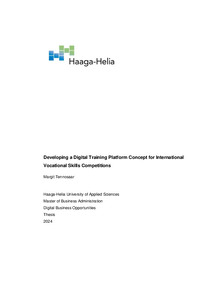Developing a Digital Training Platform Concept for International Vocational Skills Competitions
Tennosaar, Margit (2024)
Tennosaar, Margit
2024
Julkaisun pysyvä osoite on
https://urn.fi/URN:NBN:fi:amk-202404197015
https://urn.fi/URN:NBN:fi:amk-202404197015
Tiivistelmä
Vocational skills competitions are contests for vocational education students, primarily up to 22 years old, in around 50 skill categories representing various occupations and professions. The goal of the skills competition is to popularise and introduce vocational education. In Finland, the non-profit organisation Skills Finland coordinates the vocational competition system. Competitors for international skills competitions are selected approximately one year before the contest and will go through competition-specific preparation within skill-specific training groups.
This thesis aimed to research the possibilities of enabling Skills Finland's digital transformation through a digital training platform that would facilitate the monitoring and documentation of the Finnish national team's preparation for the international vocational skills competitions. Two main research questions were raised to ensure the research achieves its objectives: 1) how training is currently organised and 2) what features the new training platform should have.
The theoretical framework contains two essential subdivisions. The first part clarifies the meaning of human-centred design and opens the Service Design approach, including introducing the Double Diamond model and Lean Service Creation toolkit. The second part of the theoretical framework chapter focuses on the pedagogical approach to explain how to train for top performance, what educational theories should be followed and how this can be expanded from one competitor to the entire team.
The research adopted the Service Design approach, followed the Double Diamond phases, and utilised the Lean Service Creation toolkit and considered educational theories conceptualizing the training platform. The research is based on qualitative research methods, such as surveys and interviews.
During the data collection phase, an online survey was conducted to understand the Finnish national team's preparation process and how training for international vocational competitions is organised in Finland. The questionnaire comprised both quantitative and qualitative questions. A semi-structured interview method was utilised to increase the understanding and deepen the findings. The analysis revealed that the national team would benefit from a digital training platform that provides structure and simplifies the documentation of the training process.
During the development phase, a concept for the training platform, including its essential features, was developed. A component integration diagram was used to visualize the technical architecture and detail the platform's features. Additionally, a medium-fidelity wireframe was designed to visualize the planned layout. The training platform's main aim is to consolidate training activities, document and visualize the training cycle, and offer transparency and an overview of training progress. The concept provides a solid foundation for forming a business requirements proposal.
This thesis aimed to research the possibilities of enabling Skills Finland's digital transformation through a digital training platform that would facilitate the monitoring and documentation of the Finnish national team's preparation for the international vocational skills competitions. Two main research questions were raised to ensure the research achieves its objectives: 1) how training is currently organised and 2) what features the new training platform should have.
The theoretical framework contains two essential subdivisions. The first part clarifies the meaning of human-centred design and opens the Service Design approach, including introducing the Double Diamond model and Lean Service Creation toolkit. The second part of the theoretical framework chapter focuses on the pedagogical approach to explain how to train for top performance, what educational theories should be followed and how this can be expanded from one competitor to the entire team.
The research adopted the Service Design approach, followed the Double Diamond phases, and utilised the Lean Service Creation toolkit and considered educational theories conceptualizing the training platform. The research is based on qualitative research methods, such as surveys and interviews.
During the data collection phase, an online survey was conducted to understand the Finnish national team's preparation process and how training for international vocational competitions is organised in Finland. The questionnaire comprised both quantitative and qualitative questions. A semi-structured interview method was utilised to increase the understanding and deepen the findings. The analysis revealed that the national team would benefit from a digital training platform that provides structure and simplifies the documentation of the training process.
During the development phase, a concept for the training platform, including its essential features, was developed. A component integration diagram was used to visualize the technical architecture and detail the platform's features. Additionally, a medium-fidelity wireframe was designed to visualize the planned layout. The training platform's main aim is to consolidate training activities, document and visualize the training cycle, and offer transparency and an overview of training progress. The concept provides a solid foundation for forming a business requirements proposal.
